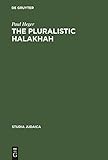The pluralistic halakhah : legal innovations in the late second commonwealth and rabbinic periods / by Paul Heger.
Material type: TextSeries: Studia Judaica (Walter de Gruyter & Co.) ; Bd. 22.Publication details: Berlin ; New York : Walter de Gruyter, 2003.Description: 1 online resource (430 pages)Content type:
TextSeries: Studia Judaica (Walter de Gruyter & Co.) ; Bd. 22.Publication details: Berlin ; New York : Walter de Gruyter, 2003.Description: 1 online resource (430 pages)Content type: - 9783110901214
- 3110901218
- 296.1/8 22
- BM520.5 .H43 2003eb
- online - EBSCO
- 11.21
- BD 3640
| Item type | Current library | Call number | URL | Status | Notes | Barcode | |
|---|---|---|---|---|---|---|---|
 eBook
eBook
|
Biblioteca "Angelicum" Pont. Univ. S.Tommaso d'Aquino Nuvola online | online - EBSCO (Browse shelf(Opens below)) | Online access | Not for loan (Accesso limitato) | Accesso per gli utenti autorizzati / Access for authorized users | (ebsco)558086 |
Includes bibliographical references (pages 385-398) and indexes.
This study examines by a meticulous analysis of abundant rabbinic citations the pluralism of the Halakhah in the pre-70 period which stands in contrast to the fixed Halakhah of later periods. The Temple's destruction provoked, for political motives, the initiation of this significant shift, which protracted itself, in developmental stages, for a longer period. The transition from the Tannaitic to the Amoraic era was a consequential turning point on the extended path from flexibility to rigidity in Jewish law.
The tension between tradition : an[d] interpretation -- Characteristics of rabbinic decision-making -- Is there a system in rabbinic decision-making? -- The development of the Halakhic system pre- and post-destruction -- Conclusion.


